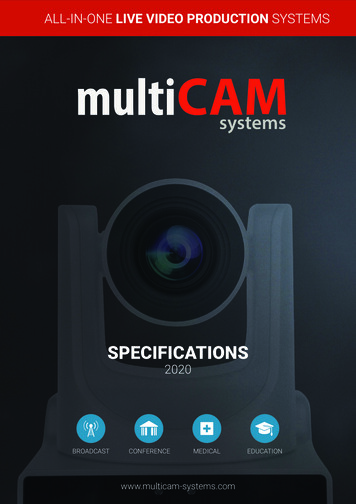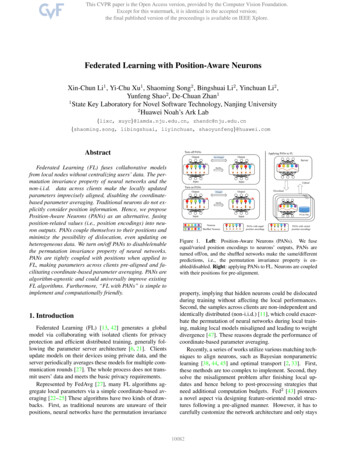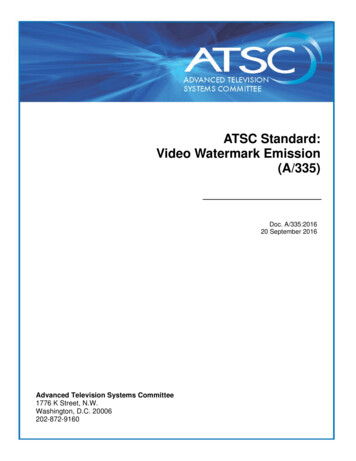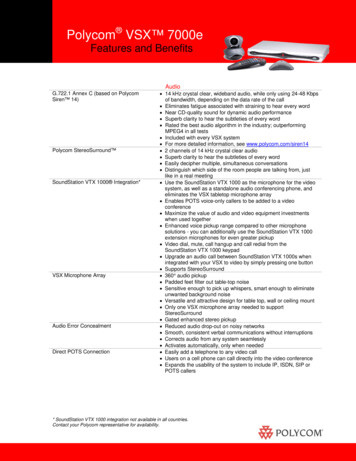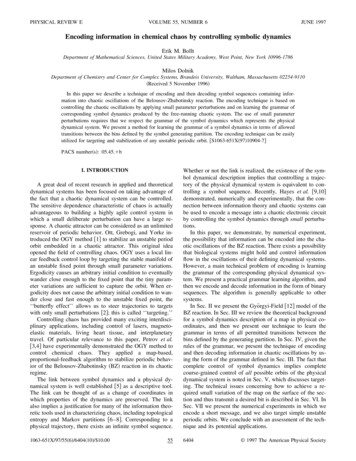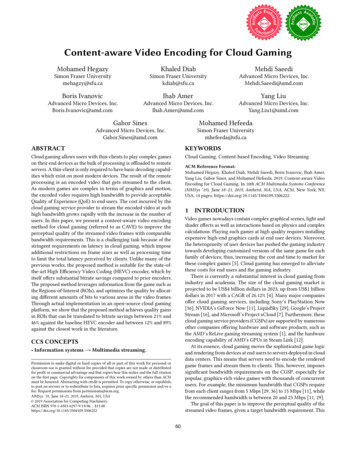
Transcription
Content-aware Video Encoding for Cloud GamingMohamed HegazyKhaled DiabSimon Fraser Universitymehagzy@sfu.caBoris IvanovicSimon Fraser Universitykdiab@sfu.caAdvanced Micro Devices, Inc.Boris.Ivanovic@amd.comIhab AmerAdvanced Micro Devices, Inc.Ihab.Amer@amd.comGabor SinesMehdi SaeediAdvanced Micro Devices, Inc.Mehdi.Saeedi@amd.comYang LiuAdvanced Micro Devices, Inc.Yang.Liu1@amd.comMohamed HefeedaAdvanced Micro Devices, Inc.Gabor.Sines@amd.comSimon Fraser Universitymhefeeda@sfu.caABSTRACTKEYWORDSCloud gaming allows users with thin-clients to play complex gameson their end devices as the bulk of processing is offloaded to remoteservers. A thin-client is only required to have basic decoding capabilities which exist on most modern devices. The result of the remoteprocessing is an encoded video that gets streamed to the client.As modern games are complex in terms of graphics and motion,the encoded video requires high bandwidth to provide acceptableQuality of Experience (QoE) to end users. The cost incurred by thecloud gaming service provider to stream the encoded video at suchhigh bandwidth grows rapidly with the increase in the number ofusers. In this paper, we present a content-aware video encodingmethod for cloud gaming (referred to as CAVE) to improve theperceptual quality of the streamed video frames with comparablebandwidth requirements. This is a challenging task because of thestringent requirements on latency in cloud gaming, which imposeadditional restrictions on frame sizes as well as processing timeto limit the total latency perceived by clients. Unlike many of theprevious works, the proposed method is suitable for the state-ofthe-art High Efficiency Video Coding (HEVC) encoder, which byitself offers substantial bitrate savings compared to prior encoders.The proposed method leverages information from the game such asthe Regions-of-Interest (ROIs), and optimizes the quality by allocating different amounts of bits to various areas in the video frames.Through actual implementation in an open-source cloud gamingplatform, we show that the proposed method achieves quality gainsin ROIs that can be translated to bitrate savings between 21% and46% against the baseline HEVC encoder and between 12% and 89%against the closest work in the literature.Cloud Gaming, Content-based Encoding, Video StreamingACM Reference Format:Mohamed Hegazy, Khaled Diab, Mehdi Saeedi, Boris Ivanovic, Ihab Amer,Yang Liu, Gabor Sines, and Mohamed Hefeeda. 2019. Content-aware VideoEncoding for Cloud Gaming. In 10th ACM Multimedia Systems Conference(MMSys ’19), June 18–21, 2019, Amherst, MA, USA. ACM, New York, NY,USA, 14 pages. ONVideo games nowadays contain complex graphical scenes, light andshader effects as well as interactions based on physics and complexcalculations. Playing such games at high quality requires installingexpensive high-end graphics cards at end user devices. Moreover,the heterogeneity of user devices has pushed the gaming industrytowards developing customized versions of the same game for eachfamily of devices; thus, increasing the cost and time to market forthese complex games [5]. Cloud gaming has emerged to alleviatethese costs for end users and the gaming industry.There is currently a substantial interest in cloud gaming fromindustry and academia. The size of the cloud gaming market isprojected to be US 4 billion dollars in 2023, up from US 1 billiondollars in 2017 with a CAGR of 26.12% [4]. Many major companiesoffer cloud gaming services, including Sony’s PlayStation Now[36], NVIDIA’s GeForce Now [11], LiquidSky [29], Google’s ProjectStream [16], and Microsoft’s Project xCloud [7]. Furthermore, thesecloud gaming service providers (CGSPs) are supported by numerousother companies offering hardware and software products, such asthe AMD’s ReLive gaming streaming system [1], and the hardwareencoding capability of AMD’s GPUs in Steam Link [12].At its essence, cloud gaming moves the sophisticated game logicand rendering from devices at end users to servers deployed in clouddata centers. This means that servers need to encode the renderedgame frames and stream them to clients. This, however, imposessignificant bandwidth requirements on the CGSP, especially forpopular, graphics-rich video games with thousands of concurrentusers. For example, the minimum bandwidth that CGSPs requirefrom each client ranges from 5 Mbps [29, 36] to 15 Mbps [11], whilethe recommended bandwidth is between 20 and 25 Mbps [11, 29].The goal of this paper is to improve the perceptual quality of thestreamed video frames, given a target bandwidth requirement. ThisCCS CONCEPTS Information systems Multimedia streaming.Permission to make digital or hard copies of all or part of this work for personal orclassroom use is granted without fee provided that copies are not made or distributedfor profit or commercial advantage and that copies bear this notice and the full citationon the first page. Copyrights for components of this work owned by others than ACMmust be honored. Abstracting with credit is permitted. To copy otherwise, or republish,to post on servers or to redistribute to lists, requires prior specific permission and/or afee. Request permissions from permissions@acm.org.MMSys ’19, June 18–21, 2019, Amherst, MA, USA 2019 Association for Computing Machinery.ACM ISBN 978-1-4503-6297-9/19/06. . . 15.00https://doi.org/10.1145/3304109.330622260
MMSys ’19, June 18–21, 2019, Amherst, MA, USAM. Hegazy et al.2is a challenging task in cloud gaming, because such an environment imposes strict requirements especially on latency and qualityfluctuations. For latency, games require high responsiveness, sincehigh latencies make players become out of sync with the serverand can cause them to lose in the game which can drive them awayfrom cloud gaming. Previous studies, e.g., [10], showed that somelatency-sensitive games require latency as low as 50 milliseconds,while most games cannot tolerate a latency above 100 milliseconds.This low latency requirement also restricts the amount of bufferinga client can have [18]. The maximum amount of data to be bufferedis at most one frame for low latency applications [42], as opposedto regular video streaming, e.g., services offered by YouTube andNetflix, which can buffer multiple frames or even seconds [33]. Inaddition, since games have frequent scene changes, encoders willgenerate more bits at these scene changes. This may result in framesof significantly different sizes, introducing rate fluctuations andpossible stalls in the video streams. Furthermore, the low latencyrequirement and the scale of current clients do not allow utilizingcomplex content analysis tools to optimize the encoding process.In this paper we propose a Content-Aware Video Encoding(CAVE) method for cloud gaming, which optimizes the quality byallocating different amounts of bits to various areas in each videoframe. CAVE has two main steps. First, it assigns weights to blocksin video frames based on the importance of these blocks from theperspective of players. It, then, allocates bits to blocks based ontheir weights, while meeting the low-latency requirement of cloudgaming and achieving consistent quality of the encoded frames.Unlike most previous works, e.g., [30, 38], we have designedCAVE for the state-of-the-art HEVC encoder [37], which by itselfachieves much higher compression ratios compared to the previous encoders. We have implemented and integrated CAVE in theopen-source GamingAnywhere cloud gaming platform [17]. Weconducted an extensive empirical study with various video gamingsegments, and measured multiple quality metrics, bitrate savings,and processing overheads imposed by CAVE. We compare CAVE tothe base HEVC encoder and the closest work in the literature [38],referred to as RQ (Rate-Quantization) method, which we implemented on top of the HEVC encoder. Our results show that CAVEconsistently outperforms both the base HEVC encoder and RQ bywide margins. For example, CAVE can reduce the bitrate neededto achieve the same quality in the most important areas (regionsof interest, ROIs) in the frames by up to 46% compared to the baseHEVC encoder running with the most recent rate control model(i.e., the λ domain model [25]). Compared to RQ, the gain is evenhigher, because the proposed content-aware rate control algorithmin CAVE is more accurate than the one used in RQ. Also, CAVE isable to run in real-time without affecting the latency requirementsof cloud gaming.The remainder of the paper is organized as follows. In Section 2,we discuss the related works in the literature. In Section 3, wepresent the details of the proposed method. In Section 4, we describeour implementation and experimental study. We conclude the paperin Section 5. In the Appendix, we describe the structure of oursource code (publicly available) and the steps needed to reproducethe results in this paper.RELATED WORKAt a high level, optimization of cloud gaming systems can be dividedinto two main areas [5]: (i) Cloud Infrastructure and (ii) Contentand Communications. The first area includes problems such asallocation of server resources to clients to maximize the user’s QoEand minimize the cost incurred by cloud gaming providers [14]. Italso includes proposing new architectures for cloud gaming systemssuch as introducing edge servers to reduce the latency perceivedby clients [8]. The second area includes various optimizations forthe compression methods of gaming content as well as adaptivetransmission methods to cope with the network dynamics [15]. Thework in this paper belongs to the second area.The second optimization area can further be divided into twocategories. The first category tries to reduce the amount of bitsneeded to transmit and render the graphical structures of games.For example, the work in [28] simplifies the 3D models of the gameon the server and sends the simplified models to be rendered onthe client device. The work in [9] constructs a base layer of thegraphical structures, which is sent to the client device. It thenencodes the difference between the full quality and base layer asan enhancement layer, which is sent to clients if there is enoughbandwidth. The second category in this area does not manipulatethe graphical structures of the content. It rather optimizes theencoding of the resulting frames to be transmitted to the clients.Methods in this second category are the most commonly used bycloud providers, as they do not require changes to the internals ofthe games. CAVE belongs to this specific category and we will thusdescribe it in more detail.Multiple works in the literature have been proposed to optimizethe quality of the encoded game video streams. In [30], an averageof the importance and the depth of pixels are used to distribute bitsin the frame and enhance their quality for an H.264/AVC encoder. Adisadvantage of this approach is that the ROI might end up with alower quality than a non-ROI, if the ROI happens to be far from thevirtual camera. In [38], an ROI-based rate control method relying ona Rate-Quantization model is devised for H.264/AVC. We improveupon their work by using the latest HEVC encoder and proposinga better weight assignment which is configurable based on thedesired discrepancy in quality between ROIs and non-ROIs.A game attention model is introduced in [2] by combining atop-down approach based on the current activity in the game and abottom-up approach based on a saliency map to reduce the bitrateby giving less important areas a higher quantization parameter(QP). However, this work does not perform rate control in the sensethat it tries to use a lower bitrate than the target bitrate. This isdone by dividing the frame into different levels of importance andassigning different QPs to them. As a result, the produced bitratewill be lower than the bitrate resulting from assigning all the areasa QP value corresponding to the highest level of importance. Inour work, we try to improve the quality of ROIs under the samebitrate. Also, the saliency models rely on expensive computationsand do not always capture the actual user’s attention. A controltheoretic algorithm is proposed in [22] to provide ROI-based ratecontrol for an H.264/AVC encoder. Unlike our proposed method,this work assumes having only a single ROI in the middle of the61
Content-aware Video Encoding for Cloud GamingMMSys ’19, June 18–21, 2019, Amherst, MA, USACloudUGameUServerU(VM)GameUClientCommandsscreen and varies its size based on the drift between the target andactual bitrates.Eye tracking data from clients are used in [19] to enhance thequality of ROIs. This approach assumes that clients have eye tracking devices at their disposal, which is not realistic as these devicesare expensive and are not relevant to the game. The impact of videoencoding parameters such as the frame rate and bitrate on theuser’s QoE is studied in [35]. This study concluded that differentencoding configurations should be employed with different gamegenres. ROI-based encoding techniques were proposed in [26, 31]for HEVC. However, these works target video conferencing applications, thus their methodology for weight calculation may not besuitable for cloud gaming as the content is significantly different.Finally, an important component of the optimization of gamevideo streams is controlling the bitrate. The relationship betweenthe distortion and the resulting bitrate can be modeled using oneof the following odingParametersVideoUEncoderFigure 1: High-level architecture of cloud gaming platformsincorporating CAVE. Low Latency. Cloud video games are highly interactive applications, where timing of events is critical. This requirementnot only restricts the time allowed for the server to renderand encode video frames, but also restricts the time neededto transmit such frames. In other words, the resulting bitrateshould not vary significantly, which puts additional constraints on the rate control model used to allocate bits toframes. Scalability. Cloud gaming servers are designed to serve thousands of users concurrently, where video streams could becustomized for individual users. Thus, the additional resources (memory and CPU) needed by any optimizationof the video streams should be minimal. For example, complex image analysis tasks cannot be performed on frames inreal time. Modular Design of Cloud Gaming Platforms. These platformsare complex systems with many software and hardware components. In real deployments, these components come fromdifferent sources and are integrated through various interfaces and APIs. That is, in many cases the cloud gamingservice provider may not have access to the source codeof individual components. For example, the video encoder,whether it is implemented in software or hardware, is typically sourced from a third-party company as a black-boxwith various APIs to configure and run it. This means that forany encoding optimization method to be practically viable, itneeds to interact with the encoder through its exposed APIsand should not assume direct access to the encoder sourcecode. Q-domain R-D [6]: creates a relationship between the bitrateand the quantization parameter. ρ-domain R-D [39]: creates a relationship between the bitrateand the percentage of transformed coefficients with a valueof zero after quantization. λ-domain R-D [25]: creates a relationship between the bitrateand the slope of the R-D curve. This model was adopted inHEVC [24] as it has shown higher accuracy in rate controlover the older pixel-wise unified R-Q model [6].In this work, we utilize and extend the λ-domain model to support optimizing the quality of game video streams while meetingthe strict latency requirements of cloud gaming.3 PROPOSED CAVE METHOD3.1 OverviewWe consider a cloud gaming system consisting of server(s) andclients. Servers are deployed in data centers of public or privateclouds. Servers are instantiated as virtual machines (VMs), whereeach instance runs the gaming engine to render and encode thegame actions generated by clients. Specifically, upon receiving aclient’s input, the server processes this input and renders the outputof the game as raw video frames. These frames are then encodedand streamed to the client. Clients, on the other hand, run simplefunctions on end user devices such as tablets, smartphones, andPCs. In particular, clients capture the players’ actions from thecontrol devices, e.g., keyboards, touch screens, and game-pads, andsend them to the server. And upon receiving the encoded videoframes from the server, clients decode and display them to theplayers. No computation-intensive tasks, e.g., graphics rendering,are performed on clients’ devices. The high-level architecture ofcloud gaming is shown in Figure 1.The proposed content-aware video encoding method, CAVE, isto be integrated with cloud gaming servers to optimize the quality of video streams delivered to gaming clients and reduce thebandwidth consumption of such streams. Achieving these goalsis quite challenging in cloud gaming, because of the following requirements:We design CAVE to satisfy the above practical requirements. At ahigh level, CAVE is implemented as a software component betweenthe Game Process and Video Encoder in Figure 1. It does not requirechanging the encoder, nor does it impose high processing overheadon the server. It controls the encoding bitrate while running in realtime to meet the low-latency requirements. In addition, CAVE doesnot maintain or use state to encode successive video frames. This isa desirable feature especially for cloud platforms, in which serversrun on VMs that can and do fail. In case of a VM failure, CAVE doesnot require any state to be transferred to the new VM instance.The cloud gaming engine performs various operations to producevideo frames to be sent to the client. It reads the inputs from the62
MMSys ’19, June 18–21, 2019, Amherst, MA, USAM. Hegazy et al.client and feeds them to a running process of the game. The cloudgaming engine captures the game frames from the GPU framebuffer. CAVE uses information about the game’s ROIs and computesvarious encoding parameters to optimize the quality. It then passesthese parameters to the Video Encoder, which produces the encodedframes sent the client.CAVE optimizes the quality by allocating different amounts ofbits to various areas (blocks) in each video frame, based on theimportance of these blocks to players. Assigning importance toblocks is not easy, especially in video games where frames typicallycontain rich and complex graphics covering most of the blocks.This complexity makes using saliency-based approaches, e.g., [2],to estimate the importance of various blocks inaccurate, becausethey rely on visual cues such as color and intensity, which do notnecessarily correlate with the player’s attention and interactionwith the game [32]. In Section 3.2, we present our proposed approach for assigning weights to different blocks, which considersthe characteristics of video games and how players interact withthem.CAVE, then, allocates bits to blocks based on their weights. Thisis a crucial step as the bitrate needs to be carefully controlled tomeet the low-latency requirement of cloud gaming, while achievinghigh and consistent quality of the encoded video frames, given a target bitrate set by the cloud gaming service provider. In Section 3.4,we present our approach for controlling the bitrate, which is designed for the state-of-the-art HEVC video encoder and extends itsbasic λ domain rate control algorithm to meet the requirements ofcontent-aware cloud gaming.3.2ROIs can include objects such as the enemy characters, health barand world map of the game. We note that ROIs depend on thesemantics of the game and the situation of players at different timeinstances. In the next section, we proved an example illustratinghow the ROI information can be exported.After defining ROIs, CAVE calculates different weights for blocksinside and outside of ROIs based on a foveated imaging and retinaleccentricity model. Specifically, the intuition behind using foveatedimaging is that the spatial resolution of the eye is at its peak atthe center of gaze. As we move further away from the center ofgaze, the resolution of information delivered by the eye decreaseslogarithmically. The angle between any perceivable detail and thevisual axis of the eye is referred to as the retinal eccentricity angle,which we denote by θ . The fovea is only capable of covering a smallvisual angle of 2 [23]. An early work [40] developed a model toapproximate the sensitivity of the human visual system (HVS) todifferent areas in an image. This model is, however, fairly complexas it depends on the spatial frequency as well the eccentricity angle.Computing spatial frequency requires applying various filters tothe image and is costly as it needs to process every pixel in a framewhich affects the end-to-end latency. And as we discussed before,the spatial frequency may not necessarily reflect the importanceof various objects to players. We simplify the model in [40] byconsidering only the retinal eccentricity angle θ . The sensitivity ofthe HVS in CAVE is approximated as: d 1 1 de tan (θ ) e tan ( D ) e D ,(1)where d is the Euclidean distance between a pixel in the frame andthe center of gaze, and D is the diagonal of the frame to eliminateany dependency on the frame resolution. Notice that the value ofd/D is between 0 and 1 and the tan 1 function on that range canbe approximated by the identity function.CAVE assumes that the center of the bounding box encompassingan ROI is the center of gaze. Based on this assumption, CAVE willassign more bits to an ROI to enhance its quality since an ROI is themost likely area that will attract the user’s attention. However, theremay be multiple ROIs in a single frame [30], and these ROIs mighthave different types which implies that they should be assigneddifferent importance factors relative to each other. Therefore, weextend Eq. (1) to support the potential presence of multiple ROIs,as follows:M1 Õ ( Kdi )/(Fi D)e,(2)M i 1Weight AssignmentPrior works, e.g., [2], considered a bottom-up approach in assigning weights to blocks. A bottom-up approach relies on the saliencyand low-level features, e.g., color, texture complexity, and spatialfrequency, of different areas to estimate their importance. As mentioned above, these visual cues do not capture the importance of various objects to players. For example, in a first-person shooter game,the target/enemy is the most important object for the player evenif its texture/color is not complex, whereas static and backgroundobjects are less important even if they have complex graphics. In addition, generating saliency maps and analyzing visual cues requireextensive image processing operations and may not be suitable forlatency-restricted cloud gaming.In contrast, we propose a top-down approach to assign weightsto different blocks, which considers the attention of players. Thatis, our approach assigns higher weights to the most relevant blocksto tasks being accomplished by players. Our approach is inspiredby previous studies [13] that show in active search tasks, top-downcues are the most relevant from the user’s attention perspective.Identifying relevant blocks is straightforward for game developers,because they know the logic and semantics of the game. Thus, theycan expose this information as metadata with the game that can beaccessed via APIs. CAVE assumes that the game developer exposessimple information about different objects in each frame. Using thisinformation, one or more regions of interest (ROIs) are defined asbounding boxes containing objects of importance to the task beingachieved by the player. For example, in a first-person shooter game,where M is the number of ROIs in the frame, K is a constant scalingfactor controlling the desired discrepancy in bit allocation andquality between ROI and non-ROI areas, di is the Euclidean distancebetween a pixel in the frame and the center of the i t h ROI and Fiis the importance factor of the i th ROI which is in the range of0 Fi 1. The importance factors Fi can be defined by the gamedevelopers based on prior knowledge of the current task or missionin the game and the importance of each ROI in achieving that task.The scaling factor K is a tunable parameter; in our experiments itranges from 2 to 10.We calculate the weight of each N N block not belonging toan ROI using the sensitivity value in Eq. (2) between its center,i.e., at position (N /2, N /2) relative to its top left corner, and the63
Content-aware Video Encoding for Cloud GamingMMSys ’19, June 18–21, 2019, Amherst, MA, USAcenter of each bounding box encompassing an ROI. For a blockbelonging to an ROI we assign to it a weight proportional to thescaling factor K and its relative importance Fi to maintain the samequality for the blocks inside the ROI. Based on our experimentsthe sensitivity values of individual pixels inside a single block donot have a large variance and thus the sensitivity value of the pixelin the center of a block is considered as a suitable representativeof the sensitivity value for the whole block in CAVE. We followthis approach to avoid processing every pixel in the frame and toreduce the overhead of the weights’ calculation.In summary, the weight w of a block whose center position is at(x, y) denoted by b[x, y] is determined as:(e 1/(K Fi )w[x, y] 1 ÍM ( Kd )/(F D)iiM i 1 e3.3if b[x, y] ROIi, iif b[x, y] ROIi(3)Figure 2: An example of simple game in Unity to illustratehow the ROI information can be exported. The tags abovethe objects are printed directly by the Unity game enginegiven the knowledge of the assigned tag to each object.Exporting ROI InformationThe ROI information is essential for any content-aware encodingmethod. One way to obtain ROI information is to use some deeplearning tools, e.g., [34], to estimate it, after the game is deployedand used by many players. Although this is possible for populargames with thousands of users from which large datasets can becollected, the time cost can be very high and may not be suitablefor real-time cloud gaming.Another way to obtain ROI information is to export such information during game development. This is not difficult as gamedevelopers already expose various other information like error logsto debug game crashes. For example, the ROI information can bestored in the Stencil buffer so that it can be intercepted during therendering process. The Stencil buffer contains information that canbe used for post-processing the rendered pixels in a frame. It isconsidered as an auxiliary buffer in addition to the essential onessuch as the frame (color) and depth buffers. It is used in [30] tohold the importance of every pixel. Processing every pixel in theStencil buffer to get the ROI information is, however, expensive. Wepropose a more efficient approach, in which the game developerassigns simple tags to game objects and these tags are used later inrun time to extract the ROI information in order to optimize thevideo coding. The tags can be accessed via an API that the gamedeveloper exposes.To illustrate our approach, we have developed a simple game,based on [21], using the popular Unity game engine. The gameconsists of a controllable player character that can move aroundin a bounded arena and collects items from the floor to increasetheir score. The game is shown in Figure 2 where the player isrepresented as a black sphere and the collectable items are shownas white cubes. To support CAVE, the game developer would needto create a few tags representing the priority of different objects inthe game. For this simple example, two tags are sufficient: playerand item. Player has higher priority; therefore, it has a differenttag than the item object. Then, the game developer would attachtags to the various objects in different frames. In addition, a simpleAPI to export the objects’ coordinates given their tags would beneeded. In the Unity framework1 , this API can have the followingsignature: List Rect getBoundingBoxes(string tag);.This API can be implemented by the game developer as follows.The player character in this game is given the tag "Player". Callingthe following function in Unity: FindGameObjectWithTag("Player") returns a Unity GameObject which is the parent of any object ina Unity game. GameObjects in Unity, such as the player object, holdas one of their properties the coordinates and bounds in 3D spaceof that object. By projecting the coordinates of the GameObjectfrom 3D space onto the screen’s 2D space, the game developer caneasily retrieve the bounding box around the object in the screen’s2D space by getting the two farthest points that were projected inthe 2D space. This projection is easy as the game developer alreadyhas the needed transformation matrices to perform this operation.The game developer can then return a list of bounding boxes (Rectobjects in C#) around the objects of the corresponding tag whenthe above API is called by CAVE.Assuming that the game is instrumented during the developmentusing the simple tags and the availability of the API described above,CAVE can perform its optimization as follows. Given that CAVE hasthe names of the different tags in the game and their correspondingimportance factors (Fi in Eq. (3)), it can then retrieve the boundingboxes and assign weights to various objects in the frame using Eq.(3).3.4Rate ControlCloud gaming service providers strive to achieve good quality ofthe delivered video streams to players, while minimizing the delivery cost. Thus, they specify an encoding bitrate that achievesa desired target video quality. The rate control component of t
Boris.Ivanovic@amd.com Ihab Amer Advanced Micro Devices, Inc. Ihab.Amer@amd.com Yang Liu Advanced Micro Devices, Inc. Yang.Liu1@amd.com Gabor Sines Advanced Micro Devices, Inc. Gabor.Sines@amd.com Mohamed Hefeeda Simon Fraser University mhefeeda@sfu.ca ABSTRACT xgames







